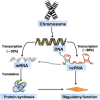Harnessing noncoding RNA-based macrophage polarization: Emerging therapeutic opportunities for fibrosis
- PMID: 33080104
- PMCID: PMC7654411
- DOI: 10.1002/iid3.341
Harnessing noncoding RNA-based macrophage polarization: Emerging therapeutic opportunities for fibrosis
Abstract
Aim: Organ fibrosis is a common pathological outcome of persistent tissue injury correlated with organ failure and death. Although current antifibrotic therapies have led to unprecedented successes, only a minority of patients with fibrosis benefit from these treatments. There is an urgent need to identify new targets and biomarkers that could be exploited in the diagnosis and treatment of fibrosis.
Methods: Macrophages play a dual role in the fibrogenesis across different organs either by promoting pro-inflammatory or anti-inflammatory responses. Noncoding RNAs (ncRNAs) have been demonstrated to play key roles in macrophage functions by manipulating macrophage polarization. Therefore, understanding the mechanism of ncRNA-associated macrophage polarization is important to move toward therapeutic interventions.
Results: In this review, we provide an overview of recent insights into the role of ncRNAs in different fibrotic diseases by modulating macrophage phenotypic plasticity and functional heterogeneity. We also discuss the potential mechanisms of different ncRNAs integrate heterogeneous macrophages in fibrogenesis,including regulatory signatures, networks, and reciprocal interactions.
Conclusions: A broader understanding of how ncRNA-directed macrophage phenotype transition in immunity and fibrosis might promote the development of a novel strategy for antifibrotic treatment.
Keywords: circular RNA; fibrosis; long noncoding RNA; macrophage polarization; microRNA.
© 2020 The Authors. Immunity, Inflammation and Disease published by John Wiley & Sons Ltd.
Conflict of interest statement
The authors declare that there are no conflict of interests.
Figures






References
-
- Zhou D, Huang C, Lin Z, et al. Macrophage polarization and function with emphasis on the evolving roles of coordinated regulation of cellular signaling pathways. Cell Signal. 2014;26:192‐197. - PubMed
-
- Mantovani A, Sica A, Sozzani S, Allavena P, Vecchi A, Locati M. The chemokine system in diverse forms of macrophage activation and polarization. Trends Immunol. 2004;25:677‐686. - PubMed
-
- Mantovani A, Sica A, Locati M. Macrophage polarization comes of age. Immunity. 2005;23:344‐346. - PubMed
Publication types
MeSH terms
Substances
LinkOut - more resources
Full Text Sources

